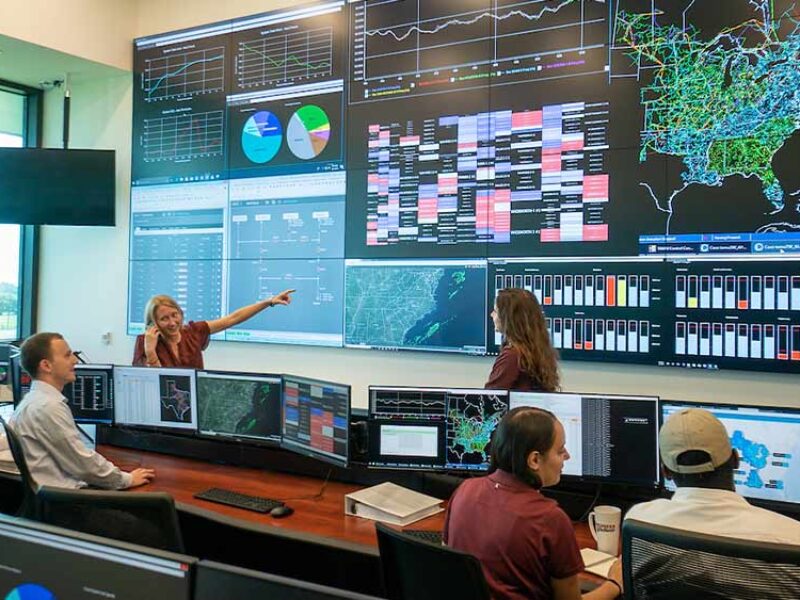US Army Selects Texas A&M Engineering For Extreme Environments Center

Pushing the boundaries of science and innovation, a research team from Texas A&M University, in collaboration with the Army Research Laboratory, and teams from the University of California, San Diego (UC San Diego), and the Georgia Institute of Technology (Georgia Tech), used the last year to develop a faster, more accurate and cost-effective method of discovering high-entropy alloys (metals produced by combining various types of materials).
After developing a machine learning framework that discovered a high-entropy alloy with enhanced strength, durability and resistance to extreme environments in record time, the Army Research Laboratory has selected Texas A&M for a High-Throughput Materials Discovery for Extreme Environments Center (HTMDEC).
“In the army, and all branches of the military, they are seeing a new landscape — the challenges, obstacles and technologies they must worry about are changing more rapidly than ever before,” said Dr. Raymundo Arróyave, principal investigator and professor in the Department of Materials Science and Engineering at Texas A&M. “Before it may have taken decades to develop an alloy for the next vehicle, tank or ballistics protection technology, but as the landscape evolves, we must innovate at an accelerated pace.”
The BIRDSHOT Center
The Army Research Laboratory deems the rapidly changing environment as a critical enabler for accelerating the pace of innovation of future fighting concepts. The HTMDEC –– otherwise known as the Batch-wise Improvement in Reduced Materials Design Space using a Holistic Optimization Technique (BIRDSHOT) Center –– at Texas A&M will serve as an epicenter for discovering and exploring novel materials for applications in extreme conditions, leading to a new frontier of innovation that combines cutting-edge technologies with critical research initiatives. This will hopefully lead to developing materials that enable the U.S. Army’s equipment to perform better in high acceleration and high-temperature environments.
The HTMDEC will be on the Texas A&M campus for four years, building on the various research findings from the previous year to tackle increasingly more intricate materials discovery problems. This announcement comes after completing Phase I of the program, which focused on developing a framework that could accelerate the materials development process.
This is because current processes for materials discovery can take decades (or much longer) to find a material that can withstand extreme environments safely and effectively. The difficulties faced using current materials discovery practices are due to the extensive amount of costly experimentation and simulation required to look at numerous potential alloy compositions.
To tackle this problem, the BIRDSHOT team, alongside teams from UC San Diego and Georgia Tech, set to create a framework that could accurately predict high-performance alloy compositions that would withstand extreme environments, at a much faster rate than has been possible in the past.
Using a combination of physics-based simulations, machine learning and artificial intelligence, within the year, these teams created a framework capable of determining the top .15% of compositions that could fit the Army’s criteria, drastically reducing the experimentation costs and duration of materials development.
By reducing the number of experiments from approximately 50,000 to merely 80, this framework found a new high-entropy alloy for the Army in less than a year. If conventional methods for discovering materials had been used, finding the same alloy would have taken centuries.
“Exploring the vast frontier of materials requires more than one set of tools; it demands an integrated approach where diverse experimental, theoretical and computational methods converge,” said Ankit Srivastava, professor in the materials science and engineering department. “In this project, and at the HTMDEC moving forward, we will simultaneously leverage all materials science and mechanics tools to embark on a true, goal-oriented journey of material discovery.”

Extensive Collaboration
This effort required two dozen students, faculty from three universities and 10 research groups, showcasing the importance and power of collaborative research efforts. Under the leadership of Dr. Ibrahim Karaman, the department aims to foster growth in these relationships through the center, benefiting the materials science and engineering fields and the university.
“Texas A&M has been investing in high throughput autonomous materials discovery research for the past few years, and now, our efforts have started to pay off,” said Karaman. “The selection of the faculty team from the Department of Materials Science and Engineering at Texas A&M who have led this new center demonstrates our faculty’s hard work and recognition in this emerging area. The close interactions with Army Research Laboratory scientists will help us to concentrate on problems related to the nation’s defense and educate the next generation workforce in the accelerated discovery of materials for the Army’s needs.”
In addition to the role of collaboration, this also offers a unique research opportunity to Texas A&M students. Mrinalini Mulukutla, a doctoral student in the materials science and engineering department, has been part of the BIRDSHOT team since the beginning. Her contribution to the project focuses on alloy design by integrating knowledge from various experiments, simulations and expert opinions.
“I have had the privilege of being a part of a scientific collaboration where each member brings a unique set of skills to solve complex scientific problems and create innovative solutions,” said Mulukutla. “I have seen firsthand how rigorous planning, meticulous experimentation and systematic data analysis are crucial for drawing meaningful conclusions. I am proud that the willingness to face challenges and embrace change has ultimately driven progress and expanded the boundaries of knowledge, resulting in an HTMDEC at Texas A&M.”
Moving forward, the goal of the HTMDEC is to eventually develop automated systems that can determine the best material possible in increasingly shorter timeframes, resulting in enhanced technologies for the U.S. Army.
This is a collaborative effort between many researchers at Texas A&M, including Dr. Ned Thomas, Dr. George Pharr, Dr. Dimitris Lagoudas, Dr. Justin Wilkerson and Dr. Douglas Allaire.
In addition, Dr. Surya Kalidindi from Georgia Tech, Dr. Ken Vecchio from UC San Diego and their respective teams from these universities play a vital role in the research and execution of these initiatives.
“I am very excited to be working with Dr. Arróyave, the Texas A&M team, and the Army Research Laboratory on research problems of national strategic interests,” said Kalidindi. “This project will bring about a major transformation in how we accelerate advanced materials-manufacturing technologies of the future.”
Media contact: Alyson Chapman, achapman@tamu.edu





